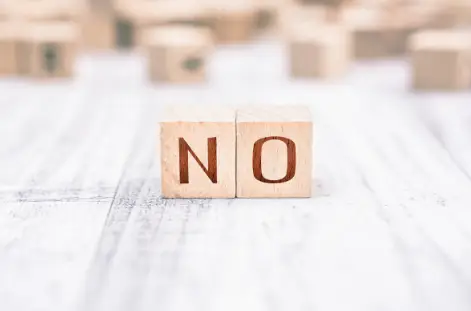I was having a conversation with a friend the other day; let’s call her Karen for the purpose of this blog. Karen has a daughter, named Lilly. Karen’s sister, Lauren, came to visit her at home, and Karen was enjoying a conversation Lilly and Lauren were having in the living room. Lauren had asked Lilly, “What is the one thing Mummy says to you all the time?” Lilly answered, “No”. There was a bit of confusion as they thought she was refusing to answer. However, she repeated, “No!” and said, “She always says ‘no!”
I found it hilarious – because her daughter just turned 5, and she can identify every parent’s most frequently used word: “NO”.
Last week we discussed the power of saying ‘yes’ and the times and places ‘yes’ is most powerful. It’s only right to bring into the conversation the word ‘No’. Its benefits are (endless if you ask me!) obvious and have withstood the test of time.
NO is able to:
Sets Clear Boundaries – it helps children understand limits and expectations. It teaches them that not all desires are immediately gratified and that certain behaviours or actions have boundaries. If you want to develop self-discipline and understanding of the structure of the world around them, then this is essential.
Builds Emotional Resilience – it allows them to experience disappointment in a safe environment. Over time, they get to gain skills for emotional development, such as coping with frustration and setbacks.
….and it establishes parental authority and trust – consistently and calmly saying “no” when appropriate reinforces your role as a reliable, guiding figure. Believe it or not, in these situations children feel safer when they know their parents are in control and looking out for their well-being, even if it means saying no to something the child wants.
Also read: The Power of Saying YES!
But let me ask you: do you say ‘no’ effectively? The power of saying ‘no’ is not in the word but in the way that it is used. If it is not used in the right way, it could have more of a detrimental impact. You want to say “no” in a way that will be effective and keep the relationship strong and the lesson meaningful:
Here are a few examples:
1. “I know you really want another cookie, but you’ve already had one. The answer is no”.
This is you being calm and confident and delivering ‘no’ in a calm, firm and neutral tone. Try to avoid yelling or getting emotional, as this can quickly heighten the situation. This kind of response also helps the child to regulate their emotions.
2. “No, you can’t stay up late tonight because you have school in the morning and you need your rest.”
Keep your explanation brief where appropriate. Kids often respond better when they understand why you’re saying no. Keep it short and clear — avoid over-explaining or debating.
3. “You can’t play outside right now because it’s raining, but you can build something with your Legos or draw instead.”
– You can offer an alternative or a choice. If possible, redirect them to something they can do. This shows empathy and helps them feel heard, not just shut down.
4. I can see you’re upset. It’s okay to feel that way. It’s hard to hear ‘no’ sometimes.”
Try to acknowledge their feelings. Let them know you understand their disappointment. This teaches emotional awareness and that their feelings are valid — even when they can’t get what they want.
In all of these four ways, the overarching effectiveness lies in your consistency. If you say no, mean it. Giving in after a tantrum teaches kids that persistence (or misbehaviour) gets results. Consistency builds trust and reinforces boundaries.
There you have it! Go forth, fellow parents – with the power of ‘no’.
Oh, and by the way, you’re doing great!


